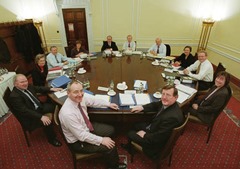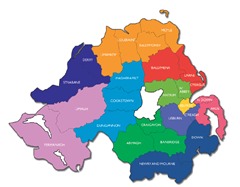RPA reviewed
 The Review of Public Administration has streamlined health and several other public services. Local government is moving ahead after delays but changes in education have stalled.
The Review of Public Administration has streamlined health and several other public services. Local government is moving ahead after delays but changes in education have stalled.
When devolution began in 1999, ministers recognised that the size and shape of the public sector had to change. The Review of Public Administration (RPA) was formally launched in June 2002 by First Minister David Trimble and Deputy First Minister Mark Durkan, with a view to finalising recommendations in late 2003.
Devolution was suspended in October of that year but the RPA continued under direct rule. A ‘further consultation’ paper in March 2005 suggested the following options: seven, 11 or 15 local authorities; five, six or seven health and social services bodies; and regional authorities for education and libraries.
The speed of change increased under new Secretary of State Peter Hain, who openly wanted to make direct rule undesirable. Hain’s ‘final decisions’ document (March 2006) controversially proposed the seven super-councils, which were supported by Sinn Féin but opposed by the other parties. The Executive increased the number of proposed councils to 11 after devolution was restored.
The other decisions were less contentious and were kept as the main framework for reform:
• a single Health and Social Care Board;
• a single Patient and Client Council;
• five geographic health and social care trusts;
• a single Education and Skills Authority;
• a single Library Authority;
Some small public bodies would be merged into the following new organisations: the Driver and Vehicle Agency; the Land and Property Services Agency; and he Northern Ireland Environment Agency.
Hain had planned to transfer fire and rescue services to the super-councils but this decision was cancelled by devolved ministers. The merger of court and tribunal administration did occur as planned, resulting in the Northern Ireland Courts and Tribunals Service.
All of Hain’s changes were to go through by June 2009.
The first result from the RPA was achieved just before restoration in April 2007, when the Driver and Vehicle Agency was formed. This was followed in April 2008 by Land and Property Services. The Environment and Heritage Service was renamed as the Northern Ireland Environment Agency in July 2008.
Libraries NI was set up on 1 April 2009. The same date marked the start of a “new era” in health and social care with the launch of the new board and five trusts. The new structures were accompanied by a new Public Health Agency and Business Services Organisation and the Ambulance Service continued to serve the whole province. The Northern Ireland Courts and Tribunals Service started work on 12 April 2010 when policing and justice were devolved.
Reform has so far stalled in local government and education, with the structures in each sector basically unchanged.
The number of councils was to be reduced from 26 to 11 in 2011. However, the DUP opposed the new boundaries when the plans came to the Executive in June 2010.
The 2011 local government elections were based on the existing model. The UUP and SDLP wanted to increase the number of councils to 15 – to make the councils more local – but were overruled by the other Executive parties. New boundaries were finalised, with minor changes, in November 2012.
The existing councils will continue in place until April 2015 as they were elected for a four-year term. Elections to the new councils are due to take place on 22 May 2014. Their members will meet in ‘shadow’ format over the following year, setting up the new headquarters and appointing senior staff.
Education
Plans to streamline education have been stalled by political division and inertia. The original deadline was April 2008 but this was cancelled as devolution was returning and education was particularly contentious.
Education Minister Caitríona Ruane announced that she would proceed with the Education and Skills Authority with the aim of setting this up by January 2010. The plans faltered over post-primary transfer, the role of the main Protestant churches and a general lack of trust.
Without an agreement, Ruane moved ahead with cuts to the staffing of the existing education and library boards. Four of the five boards were reconstituted as ‘transitional education and library boards’. The outlier is the South Eastern Education and Library Board which has been overseen by administrators since 2006, when it exceeded its budget.
John O’Dowd succeeded Ruane after the 2011 Assembly election. A DUP-Sinn Féin agreement in November of that year allowed for a new sectoral body for controlled schools and protected the status of transferors. The UUP objected to the new Education Bill, claiming that it would centralise power and undermine voluntary grammar schools, and the DUP took up the same objections.
The Bill’s committee report was published on 8 April 2013 but it has not moved forward since then.
Way ahead
Almost seven years on from restoration, there is considerable public pressure for cuts at Stormont.
It is worth noting that the Civil Service has already streamlined its back office work by introducing shared services for accountancy, human resources, telecoms, IT and records.
The independent review of economic policy (September 2009) proposed a single ‘department of the economy’ but this has not yet been implemented. Plans to abolish the Department for Employment and Learning have been put on hold.
In 2012, the Assembly and Executive Reform Committee suggested cutting the number of government departments from 12 to seven.
This would mean keeping OFMDFM and having six other portfolios: economic policy; education; health; justice; general environmental policy; and the remainder of social policy.
However, no political agreement has yet been signed. A lot depends on whether junior ministers would work with senior ministers from a different party, and the potential balance of unionists, nationalists and others in the Executive.
Reducing the size of the Assembly itself is another highly political issue. Based on the 18 constituencies, the most likely trend would be a cut from 108 to 90 or 72.

